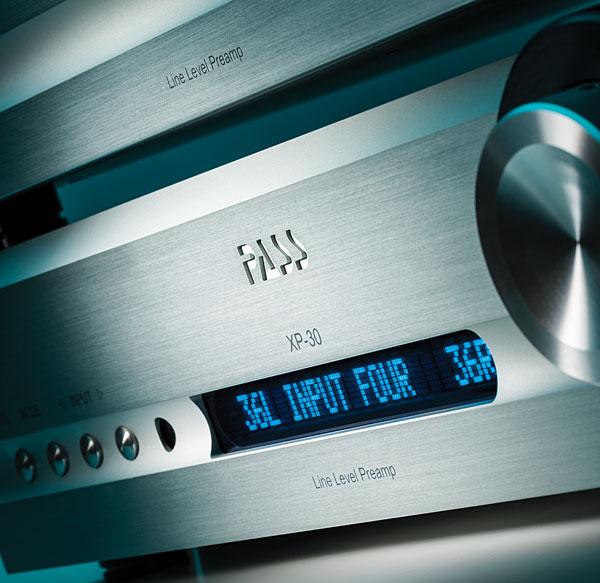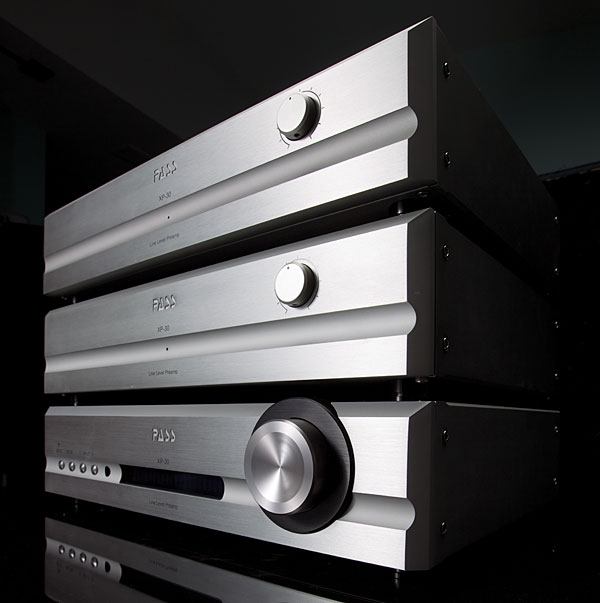Pass Labs XP-30 Ref Line Pe Amplifier:
Listed · 807 Views
This listing has ended.
Listings Similar to Pass Labs
Time Left: Listing Sold
This listing has ended.
| Condition | |
| Payment methods | |
| Ships from | Los Angeles, CA, 90077 |
| Ships to | United States and Canada |
| Package dimensions | unspecified |
| Shipping carrier | UPS |
| Shipping cost | |
| Original accessories | Box, Manual |
| Research Pricing |
Pass Laboratories Thee Chassis Reference XP-30 Line Pre amplifier as new factory boxed:

Please note: we also have available the Pass Labs 160.8 reference model blocks and the matching phono section, SME 30.2 table and latest SME arm, Esoteric Keo, one reference CD player And Magico speakers available and all listed separately on Audiogon.
It is best to call for more information.
No low offers considered and the right buyer will appreciate this as new reference line stage.
Also available and posted separately: We have available the matching Pass Labs XP-160 mono blocks, XP-25 phono.
The XP-30 is a three-piece modular preamplifier consisting of one
control/power supply chassis and two additional gain chassis each
containing analog signals of a single channel. The XP-30 generates less
noise, crosstalk and distortion while delivering greater dynamic range,
gain, output voltage and output current. But it is the sound, not the
technical excellence, that truly makes this a breakthrough instrument.
Stereophile Rave Review states: https://www.stereophile.com/content/pass-laboratories-xp-30-line-preamplifier-page-2
Sound quality:
I was alarmed when I first set up the XP-30: I could get no sound out of
it. After much troubleshooting, including rebooting the preamp several
times, it turned out that the problem was the AudioQuest Wild Blue
balanced interconnects I was using between the dCS Debussy DAC, the XP-30, and the Classé CTM-600 monoblocks. I replaced these cables with the Cardas-sourced Ayre balanced interconnects I'd borrowed to use for my review of Ayre's K-5xeMP preamp, and music burst forth from the speakers.
I informed Pass Labs of a possible incompatibility between the XP-30 and
the AudioQuest cables; they obtained some samples from AQ and found
that everything worked properly. I put the problem down to my usual bad
kable karma and sat down to some critical listening. I put on a CD
Stephen Mejias had given me as a Christmas present: Hildur Guðnadóttir's
Leyfðu Ljósinu (Touch TO:90). Recorded live, primarily with a
Soundfield microphone, the album begins quietly with cello and voice,
but develops into enveloping soundscapes of vocal textures over a looped
motif based on a major second interval. I had meant to listen for only a
few minutes, to ensure that all was working correctly, but before I'd
realized it, the 40-minute CD had played all the way through.

Hmmm. The sonic characters of the preamplifiers I have enjoyed using
over the past decade or so range from the airy if light-balanced Parasound Halo JC 2 to the dark-toned Mark Levinson No.380S. The Nagra Jazz, reviewed elsewhere in this issue,
lies closer to the Parasound in its sonic signature but approaches the
Levinson in its ability to throw a billowing soundstage. The Simaudio Moon Evolution P-8, Audio Research Reference 3, Ayre Acoustics KX-R, and, to a lesser degree, Ayre's K-5xeMP,
are all soundstaging champs, but excel at reproducing, along with the
soundstage, the palpability of individual acoustic images. The ARC and
the Ayre K-5xeMP push the image forward a little, the
Simaudio and the Ayre KX-R present a deeper, more resolved soundstage.
But of all these preamps, it was the Ayre KX-R and Moon P-8 that for me
most effectively communicated the music—as the Pass Labs XP-30 was now
doing.
The weekend I had installed the XP-30 in my system, I had ripped a favorite organ recording, Philip Ledger's Organ Music from King's (EMI HQS-1356), to 24-bit/192kHz AIFF files using Ayre's QA-9 A/D converter. Listening to Vaughan Williams's serene prelude based on the Welsh hymn tune "Rhosymedre" with the XP-30 feeding Lamm's M1.2 Reference
monoblocks, I was struck by how well delineated were the spatial
effects on this recording. Ledger repeats the tune on different stops of
the King's College Chapel organ; the ranks of pipes represented by
these stops are in different parts of the sanctuary and all of their
position were unambiguously presented by the XP-30. And the
lowest-frequency pedal notes had impressive weight and authority.
As I was writing this review, I picked up a hard drive from Systems Two
Studio in Brooklyn containing engineer Mike Marciano's final 24/88.2
mixes of Sasha Matson's jazz opera Cooperstown, which I had
produced. As I listened to these files, the XP-30–centered system became
a time machine! I was transported back to last September and Bill
Schnee's studio, in North Hollywood, where we'd recorded the voices. Our
canaries—sopranos Julie Adams and Carin Gilfry, tenors Daniel
Montenegro and Daniel Favela, bass Rod Gilfry—materialized in my room.
Their voices had been recorded dry, but each was convincingly enveloped
in just the right amount of supportive ambience, which Mike had supplied
with a Pro Tools reverb plugin set to "Concertgebouw."
Time machine? The phrase sounded familiar. And there it was in
the XP-30's owner's manual: "The XP-30 is a time machine, offering a
greater 'look-back' at the original musical performance and conveying
additional insight [into] the artist's creative intent."
Yes indeed. Back in the 1970s, I fell in love with the recordings coming
from Philadelphia's Sigma Sound Studios, particular of the Stylistics.
Some of this vocal group's songs descended into mawkishness, but one,
the Thom Bell–produced and –written "You Make Me Feel Brand New," from
1973, shone back then like a finely crafted gem.
It still does. I put the Stylistics' Rockin' Roll Baby LP (Avco) on the Linn, with the Liberty phono preamp
feeding the XP-30. It all came back to me. The intro features a Coral
electric sitar intoning a melodic fragment from the song's chorus over a
backing from acoustic piano and Fender Rhodes. This is standard
practice from The Professional Arranger's Handbook, but is none
the worse for that, the attractive hook leading to a stately dotted
rhythm in E major, sustained by lusciously slow stereo vibrato on the
Rhodes piano. E has always been a dark key for rock music, but even as
the verse showcases Airrion Love's baritone, hints of tonal
schizophrenia creep in with the inclusion of a C natural in the melodic
line, and within 10 measures, the song changes gear and modulates up to
G.
Straight A1/A2 form so far, but then a B minor coda is tacked on to the
verse, with the eerie tenor of Russell Thompkins Jr., doubled on sitar,
leading the way to the chorus. We're still in G, but the first chord
here is a C major 7, and it isn't until the end of the chorus that we
resolve on a G major chord, the song apparently pretending it's in E
minor most of the way. Even then, though G is now firmly established as
"home," this isn't for long, as the melodic fragment used for the intro
pivots on the note B—the median of G major, the dominant of E major, and
also the added note in the honey-sweet C major 7 chord—to lift us up
to E major for the start of the next verse. As with M.C. Escher's
waterfall lithograph, we've changed harmonic gear twice, both times in
an upward direction, yet we're back where we started, in E major, and
ready to go up again.
Add to this repeated intensification of emotional tension Thom Bell's
sympathetic use of strings and "flavoring" instruments like the vibes,
which lead into the second verse to underline the unusual vocal scoring,
where Thompkins's high tenor allows the harmonies to support the melody
from beneath rather than surround it from above, and it perhaps
becomes more clear why this deceptively simple song sounds just as
gripping nearly four decades after I was first captivated by it.
Hmm. I am supposed to be writing about sound. Instead, I've just devoted three paragraphs to musical
analysis. This is typical of what kept happening during my time with
the XP-30: I'd focus on the sonic aspects of what I was hearing, but end
up thinking about aspects of the music.
Again from the XP-30's manual: "The XP-30 will help you rediscover the joy of your record collection." Indeed it did!
Summing up :
Ayre's KX-R
and Pass Laboratories' XP-30 represent the opposite ends of the
spectrum of preamplifier design. The Ayre has zero negative feedback,
even in its power supply, and mechanically coupled potentiometers for
volume control; the Pass uses negative feedback both in its audio
circuit and in its many three-pin voltage-regulator chips, and has an
integrated-circuit volume control. It's been four years since I had the
Ayre KX-R in my system, and yes, auditory memory is notoriously fickle.
But my auditioning convinces me that Pass Labs' XP-30 equals the sound
quality of the Ayre. The XP-30 has rekindled for me the concept that the
beating heart of an audio system is the preamplifier. This is one you
need to hear for yourself.
===============================================
Description: Remote-controlled, three-chassis line preamplifier.
Analog inputs: 6 balanced, 6 unbalanced, plus Tape Input. Analog
outputs: 2 pairs (1 variable-level, Master; 1 fixed-level, Slave)
balanced on XLRs; 2 pairs (Maater, Slave) unbalanced on RCAs.
Gain
range: –90dB to +10dB in 99 steps of 1dB.
Frequency response: 2Hz–60kHz,
–3dB.
Signal/noise: >110dB ref. 5V.
Channel separation: 100dB at
1kHz, ref. 1V. CMRR: 60dB at 1kHz.
Input impedance: 42k ohms, balanced.
Output impedance: 120 ohms, single-ended; 120 ohms, balanced.
Power
consumption: 45W.
Dimensions: (each chassis) 17" (432mm) W by 4" (102mm) H by 12" (305mm) D. Shipping weight: 75 lbs (34kg).
Price: $16,500. Approximate number of dealers: 15.
Manufacturer: Pass Laboratories Inc., PO Box 219, Foresthill, CA 95631. Tel: (530) 367-3690. Fax: (530) 367-2193. Web: passlabs.com.
=====================================================
It
is best to call David and visit: www.weinhartdesign.com with questions
in Los Angeles Showroom 310-472-8880 or on my cell after hours and
weekends 310-927-2260 any time from 10AM - 10PM.
Weinhart
Design has lots of other items new and used and if you're in Los
Angeles or visiting please accept my invitation to experience our World
Class Audio Showroom and please visit our web site @
www.weinhartdesign.com
We
are always interested in purchasing quality Audio and Video items, LP collections and most quality trades are welcomed.
All sales out of California are State Sales Tax exempt.
California State Sales Tax of 9.5% applies for items picked up or shipped to a California address.
We
accept payments by Bank Wire Transfers without fees and is the only
form of payment on all sales out of the U.S. and Canada. We prefer this
method of payment and also makes shipping to addresses other than
billing agreeable.
VISA, MC and Papal are gladly accepted within
the U.S. and Canada as long as the charge is approved and shipping to
the billing address on record and adds 3% to cover costs.
Please
call me directly in my world class showroom in Los Angeles weekdays @
310-472-8880 or any reasonable time on my cell including weekends @
310-927-2260 and I can answer your questions and help you with all of
your new and pre owned needs.
Changing the Way You Listen,
David Weinhart
Weinhart Design, Inc.
President & CEO
[email protected]
www.weinhartdesign.com
The Audio and Video Expert
2337 Roscomare Road, Studio #1
Los Angeles, California 90077
Showroom) 310-472-8880
Cell) 310-927-2260
No questions have been asked about this item.
Ask the seller a public question
You must log in to ask a question.
Return Policy
Return Window
Returns are not accepted on this item.


